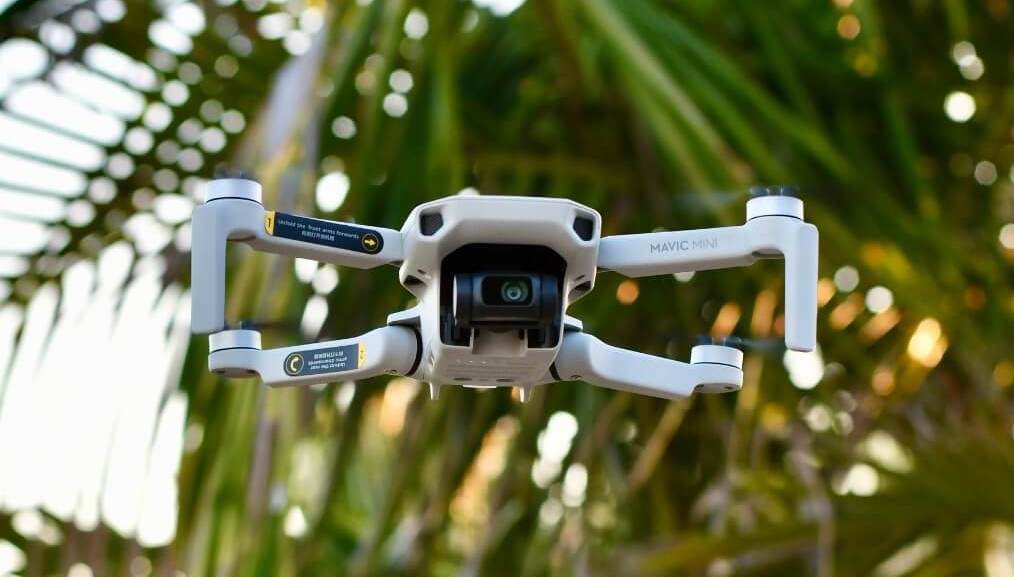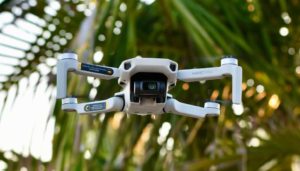Check out this DJI Mavic Mini Review to see if it’s the right drone for you!
- lightweight
- good picture and video quality
- great battery life
- no need to register with the FAA
- automated quick shots
- gimbal stabilization
- low cost for entry drone
- lack of 4k video
- spotty connection
- no RAW photos
- sensitive to winds higher than 15 MPH
- no internal storage
Advertised as the “Everyday Flycam,” the DJI Mavic Mini is a pocket-size drone that has changed the idea of an entry-level drone. Coming in at just 249 grams, an important number in the drone world, the Federal Aviation Administration (FAA) does not require flyers to register with their Unmanned Aircraft Systems (UAS) records. Despite this, the Mavic Mini is a powerful drone that packs many features seen in DJI’s more expensive models.
1. Picture Quality
Rating: 8.5/10
The Mavic Mini offers a 1/2.3-inch image sensor for 12 MP still images with a fixed f/2.8 aperture. The frame is equivalent to a 25mm lens and produces stunning images given the size and quality of the drone. Unfortunately, the Mavic Mini does not support RAW images and only produces JPEG files.

2. Video Quality
Rating: 8/10
Adding on to the camera specs, the Mavic Mini supports 2.7k video resolution and offers the choice of 24, 25, or 30fps frame rates. It’s unfortunate there is no 4k video resolution or 60fps options available, which would push the drone to more of a top tier model. However, these features can easily be found on the Mavic Air 2 and Mavic 2 Pro models.
An additional feature that can be used while taking video is Quickshots. This allows the drone to perform preset motions while focusing on a target set by the flyer. Quickshot modes include Dronie (slanted upwards motion), Rocket (straight upwards motion), Circle (circular motion), and Helix (circular upwards motion). You can set various distances for the drone to perform with the Quickshot and are best for when you’re on-the-go.
3. Flight time
Rating: 9/10
DJI advertises a 30-minute flight time, however, realistically I estimate around 25 minutes especially in sensitive weather conditions (i.e., high winds, cold/hot weather, etc.). For a consumer drone, this is still a great battery life and the flight time could be extended with the purchase of additional batteries.
The starting price for the Mavic Mini is $399 and comes with the basics such as the aircraft, remote controller, flight battery, and extra propellers. There is a second option, the Fly More Combo ($499), which includes all the basics, additional quantities of batteries and propellers, 360° propeller guards, charging hub, a DJI 18W USB charger, and a carrying case. I would highly recommend the second combo purely for the extra batteries and charging hub, which is a life-saver when you’re traveling.
4. Weather Circumstances
Rating: 7/10
The Mavic Mini is said to have a maximum wind speed resistance of 28.8 KPH, or 17.9 MPH, due to its lightweight and compact dimensions. In my experience, winds higher than 15 MPH make the Mavic Mini susceptible to shakiness and slight loss of control. This is an important factor to consider when preparing for takeoff and is something I often judge when checking off a mental list of whether it is safe to takeoff. Flyers must remember that if it’s windy on ground level then it’s even windier several feet above you. Fortunately, the Mavic Mini will display a warning sign when it detects strong winds and will prepare to land if further action is not taken.
5. Responsiveness
Rating: 7/10
Reaching a maximum flight distance of 16 km and a maximum takeoff altitude of 3000 m, it’s important that the remote control can communicate with the aircraft quickly and without any interference. Generally, the Mavic Mini can accomplish this. Nevertheless, out of the 40 flights (and counting) I have done, there have been a handful of times where there is an interference of some kind and I lose partial or all control of the aircraft for a few minutes. As you can imagine, this can be a very stressful time since the live feed turns black and I have to chase after it to get signal again. On top of that, it is almost impossible to gauge with the naked eye where the drone is in the sky because it is so small, and the grey color blends into the sky very well.
Last Thoughts
The Mavic Mini is a very portable and strong choice for an entry-drone but it isn’t perfect. Although I would highly recommend this drone to those who are beginners, I will warn you that at some point you will become unsatisfied. Once you become very comfortable with flying this drone and taking advantage of what it can offer, you will be back to looking for the “next thing” before you know it. Likely you will be looking forward to purchasing one of the higher-end models that DJI has to offer and all the extra features it can provide for you that the Mavic Mini lacks (i.e., greater camera/video resolution, internal storage, more flight time, more Quickshot options, etc.).
The Mavic Mini is also a great option if you just simply do a lot traveling and want a drone that is easy to transport and doesn’t take up a lot of room. Get started with purchasing your own Mavic Mini today!





